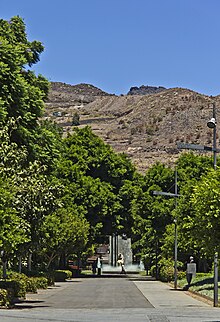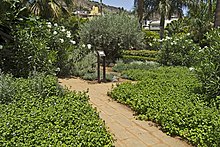Parque García Sanabria
The Parque García Sanabria is a 6.7 hectare park in the northern part of downtown Santa Cruz de Tenerife .
History of the park
In 1881, the journalist Patricio Estévanez suggested creating a park on what was then the edge of downtown Santa Cruz de Tenerife. Seven years later, the “Sociedad Constructora de Edificios Urbanos”, a company commissioned with the expansion of the city, bought the site on which the listed district of the Barrio de los Hoteles is now, which also includes the park. As part of a plan to improve hygienic conditions, the city architect Manuel de Cámara and the pediatrician Dr. Diego Guigou for the creation of a public park where the children of the nearby neighborhoods could enjoy the fresh air. In 1910, the city architect Antonio Pintor designed a park that was to be surrounded by a high fence and accessible through two large gates. Where exactly this park could be created was not clear from the plan. After 1914 the idea arose of building a branch (Hijuela = little daughter) of the Jardín de aclimatación de La Orotava in Santa Cruz, as had already happened in La Orotava on the site of the former monastery of San José . The cost of such a park should then be borne by the Ministry of Agriculture. It was not until 1924 to 1926, more than forty years after the initial efforts, that the mayor Santiago García Sanabria began to collect donations in cash and in kind (plant cuttings) and to make public funds available to the city administration to finally open the park in 1926 to put on the then wasteland. In the following decade, the park was provided with irrigation and lighting. Between October 6, 2004 and June 9, 2006, the park was closed and, to a large extent, renovated or redesigned without changing the basic structure. This redesign is most noticeable in the newly built children's playground.
Structure of the park
The park is characterized on the one hand by one vertical and two diagonally running, wide paths lined with flower beds that correspond more to a baroque garden design and on the other hand by the spiral paths that z. Sometimes they have densely overgrown and very differently designed landscapes. The parts of the park opened up by the spiral paths are areas with (today) a dense population of deciduous trees and palm trees, but also plants with plants that are atypical for the Canary Islands, e.g. B. a bamboo path , a rose garden, a casuarina path or a cactus garden ; The lotus flower pond with goldfish in Santa Cruz is also more exotic. A large part of the plants has been provided with information signs since 2006, which provide information about their origin, distribution and special features. Since 1994, the paths have been named after ten people who were important for the city's cultural life. Apart from the central monument, there are three other fountains.
The terrace café on the south-east side of the park towards the city center is not primarily aimed at tourists, but rather at residents of the surrounding districts. Directly next to this café is a large clock, the dial of which is planted with different flowers depending on the season. The watch was built in 1958 by the Swiss company Favag and financed by the Danish consul P. Larsen. The herb garden with different kitchen herbs common in Spain and the Mediterranean area occupies a rather closed space in the southwest corner of the park. A fenced area in which dogs are allowed to run free is intended to encourage dog owners to keep the animals on a leash in the rest of the park area. In the northern corner of the park, where there used to be a small zoo, a building has been erected where art exhibitions take place at irregular intervals.
Sculptures and sculptures
The sculptures and sculptures that are (as of 2012) in the park can basically be divided into three categories:
Monuments for people
The people were all born in Santa Cruz de Tenerife.
- Leopoldo O'Donnell y Jorris, born in 1809, was a general and Spanish Prime Minister several times.
- Leonor Pérez Cabrera , born in 1828, is considered an important political activist who was active in Mexico and the Caribbean. She became particularly known as the mother of the Cuban revolutionary José Julián Martí Pérez . The sculpture created by Thelvia Marín.
- Dr. Diego Guigou y Costa, born in 1861, was the founder of the first children's hospital in Santa Cruz de Tenerife, one of the first in Spain. He was very committed to the establishment of the park. The bronze relief was created by Francisco Borges Salas.
- Diego Crosa (called Crosita), born in 1869, was a writer, dramaturge, painter and caricaturist.
- Emilio Calzadilla y Dugour, born in 1875, was a lawyer and politician. The monument was created by Jesús María Perdigón.
- Ramón Gil-Roldán y Martín, born in 1881, was a politician, lawyer and writer. The monument was created in 1968 by Nicolás Granados.
- Santiago García Sanabria, born in 1880, was Mayor of Santa Cruz de Tenerife. The park was laid out during his tenure. The current layout of the central memorial in his memory basically consists of three components: 1. The memorial consisting of several blocks of different sizes. This monument was designed in 1936 by the architect José Enrique Marrero Regalado and erected in 1938. The location of the monument was controversial before its creation until an agreement was reached on the intersection of the main axes of the park. 2. The portrait relief of Santiago García Sanabria, the relief images on the east side and the west side and the sculpture "La Fecundidad" ("Fertility" known as "La gorda del parque") appear to the viewer stylistically as a typical creation from that time of Frankism. They were created in 1936 (before the start of the civil war) by the artist Francisco Borges Salas. The sculpture "Fertility" was stored in a municipal depot at the time of the Francoist cultural policy, as it was an "immoral representation". Only when the fountain system was redesigned by Carles Buigas was the sculpture taken from the municipal depot after twenty years and integrated into the ensemble as the architect of the monument had planned. 3. The fountain that surrounds the monument was redesigned in the 1990s.
Sculptures and sculptures from the Exposición Internacional de Escultura en la Calle
As part of the Exposición Internacional de Escultura en la Calle of the Chamber of Architects, various works of art were set up in the park in 1973/74.
- Federico Assler, sin titulo
- Jaume Cubels, sin titulo
- Óscar Dominguez, Monumento al gato
- Amadeo Gabino, Estela Espacial
- Josep Guinovart, sin titulo
- Remigio Mendiburu, Dado para 13
- Mark Macken, Solidaridad
- Eduardo Paolozzi, Homenaje a Gaudí
- Josep Maria Subirachs, introversión
- Pablo Serrano, Homenaje a las Islas Canarias
- Gustavo Torner, Laberinto: Homenaje a Borges
- Claude Viseux, Homenaje a Millares
Other sculptures and sculptures
- Gonzalo González, Signos de lo natural
- Eladio de la Cruz, adolescents
- José Blasco, Monumento al clima
- Las Estaciones, The sculptures of the four seasons were donated to the city of Santa Cruz de Tenerife by Francesco Genova in 1962.
Events in the park
The city administration regularly offers natural history tours through the park. As part of the annual “Día de la Cruz” celebrations on May 3rd, a local holiday, tents are set up along the wide paths of the park, in which mainly flowers and handicrafts are sold. In front of the central monument and at the entrance next to the café, stages will be set up on which there will be music and theater performances for children too. The tents usually stay there to be used by booksellers and publishers for the “Feria del Libro” at the end of May. Poetry readings and autograph sessions also take place here. In the entrance area on the south-east side of the park, a video wall will be set up for public viewing on appropriate occasions .
Individual evidence
- ↑ Luis Cola Benítez: Los inicios del Parque. La Opinión, February 12, 2012, accessed August 2, 2012 (Spanish).
- ↑ Detailed information about the different plants can be found in the brochure "Ruta Botánica" of the municipality of Santa Cruz de Tenerife: Parque García Sanabria. (PDF; 1.8 MB) Ruta Botánica. Excemo. Ayuntamiento de Santa Cruz de Tenerife, accessed December 15, 2012 (Spanish).
- ↑ The term flower clock does not actually apply to the system.
- ↑ Periódico el Día: Reinstalan la maquinaria del reloj de flores, rota por los niños. El Día, May 18, 2012, accessed December 13, 2012 (Spanish).
- ↑ Los tesoros del parque. ElDia.es, June 13, 2006, accessed December 15, 2012 (Spanish).
- ↑ Isidoro Sánchez García: Thelvia Marin Mederos. (No longer available online.) August 28, 2012, archived from the original on December 23, 2012 ; Retrieved December 15, 2012 (Spanish). Info: The archive link was inserted automatically and has not yet been checked. Please check the original and archive link according to the instructions and then remove this notice.
- ↑ Naima Pérez: El parque de los once nombres. laopinion.es, March 5, 2012, accessed December 13, 2012 (Spanish).
- ↑ Escuturas en la Calle - Primera Edición 1973. (No longer available online.) Colegio Oficial de Arquitectos de Canarias, archived from the original on March 2, 2012 ; Retrieved May 20, 2012 (Spanish). Info: The archive link was inserted automatically and has not yet been checked. Please check the original and archive link according to the instructions and then remove this notice.
literature
- Juan Manuel Palerm Salazar and Leopoldo Tabares de Nava y Marín: Arquitectura como paisaje: un jardín en el Atlántico: Parque García Sanabria . Ediciones Saquiro, Santa Cruz de Tenerife 2009, ISBN 978-84-612-1894-3 (The book explains the background to the renovation of the park from 2004 to 2006).
- Gilberto Alemán et al .: El Parque Municipal García Sanabria . Excmo. Ayuntamiento de Santa Cruz de Temrife, Santa Cruz de Temrife 2006, p. 94 (Spanish, santacruzdetenerife.es [PDF]).
- Carmen Milagros González Chávez: Los projectos de urbanización del Parque García Sanabira en Santa Cruz de Tenerife . In: Revista de historia canaria . No. 185 , 2003, p. 201–210 (Spanish, ull.es [PDF; accessed on July 6, 2016]).
Web links
Coordinates: 28 ° 28 ′ 20.3 " N , 16 ° 15 ′ 14.8" W.





